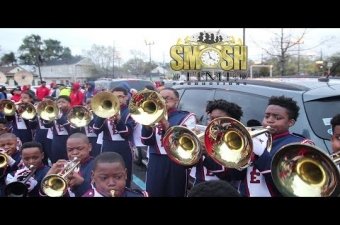
Music Education
Music Education in New Orleans
Jazz patriarch Ellis Marsalis’ famous observation that New Orleans culture “bubbles up from the streets” is sometimes invoked to suggest that the city’s music is naturally occurring, like an underground spring just waiting to be tapped. In fact, Marsalis was differentiating New Orleans from places where culture is imposed “from on high.” He knew better than anyone that music doesn’t just happen—he raised a family of musicians, trained generations of performers and teachers, and established jazz studies programs at multiple schools and universities. His career as an educator is a testament to the work required to keep the culture bubbling.
Throughout the city’s history, institutional support for this effort has been hard to come by. Jazz was prohibited in New Orleans schools for most of a century after its birth, on racist and classist grounds. A few early jazz musicians taught themselves, but often they learned from elders, sometimes relatives or neighbors, or in private lessons with professionals. Promising students graduated to on-the-job training: New Orleans bandleaders have a long history of recruiting apprentices to perform with them. Once they joined the professional ranks, the density of bandstands in the city made it easy for musicians to listen to and learn from their peers.
Some jazz pioneers like Jelly Roll Morton studied music formally, while others learned by ear. A typical early jazz artist grew up surrounded by music: at home, in church, in parks, in barrooms, and, sure enough, from the streets, in parades and funeral processions, from buskers and bands advertising themselves on flatbeds of passing trucks. Music performed various functions in everyday life in New Orleans, and musicians often trained to be versatile enough to find employment in different settings.
As for classroom instruction, the city maintained two segregated school systems well into the 1960s, with Black students often crowded into run-down facilities. Some of their music teachers, like the venerable Yvonne Busch, let a little jazz into their lessons, official policy notwithstanding (Busch also encouraged students interested in playing rhythm and blues outside of school). In this era, music programs for both Black and white students generally used conventional curricula, the kind found in schools across the country.
Some Black musicians found opportunities for post-secondary education through the military—rhythm and blues architect Dave Bartholomew honed his music writing and arranging skills in the 196th Army Ground Forces Band during World War II. Others, including members of the legendary house band at J&M Studio, used the G.I. bill to enroll in private music schools in New Orleans. A Korean War veteran, the producer and arranger Wardell Quezergue, tapped his formal training to compose elegant songs in popular genres like R&B and funk, leading Allen Toussaint to dub him the “Creole Beethoven.”
New Programs Follow Desegregation
The face of music education in New Orleans changed in the late 1960s and early 1970s, when, after more than a decade of resistance, the city’s school system desegregated in earnest. The ensuing departure of white students meant public school bands became predominantly Black cultural institutions. Marching bands in particular gained city-wide prominence through their performances in Mardi Gras parades. Though the schools were chronically under-funded, devoted band directors and boosters helped make these programs points of pride in New Orleans. They also produced musicians who would power the brass band revival of the 1980s and 90s (several after-school programs and summer camps contributed on that front, too).
Marsalis helped inaugurate the first formal jazz program in the city’s public schools at New Orleans Center for Creative Arts (NOCCA) in 1973. It cultivated students’ awareness of music history and business savvy along with their instrumental chops, and launched a slew of nationally influential artists including including Donald Harrison, Jr., Harry Connick, Jr., Nicholas Payton, Troy “Trombone Shorty” Andrews, Christian Scott aTunde Adjuah, and Jon Batiste (as well as Marsalis’ sons, Branford, Wynton, Delfeayo, and Jason).
Marsalis also founded the jazz studies program at the University of New Orleans in 1988, tapping the great Harold Battiste, an old bandmate, as a professor. Other world-class teaching artists anchored university programs in the area, including Alvin Batiste at Southern University in Baton Rouge, Edward “Kidd” Jordan at Southern University in New Orleans, Dr. Michael White at Xavier University, Maynard Chatters at Dillard University, and Terence Blanchard (another NOCCA alumnus) at the University of New Orleans and the Monk Institute at Loyola University.
Post-Katrina Developments
In the aftermath of Hurricane Katrina in 2005, the city laid off public school teachers en masse and thousands, including veteran band directors, were never rehired. The post-Katrina displacement of roughly 100,000 Black residents from New Orleans also did heavy damage to community-based music instruction in churches and homes, as many students lost contact with elder artists.
In the absence of systemic public support, privately funded non-profits sought to fill in some of the gaps. Since 2008, one of the most successful has been the Roots of Music, an after-school marching band for middle-schoolers, the brainchild of Rebirth Brass Band snare drummer Derrick Tabb. Growing up in Treme in the 1980s, Tabb learned to play by following the second lines that went by his house, practicing with his neighbors, and being drilled by career band directors at his nearby middle and high schools. With opportunities like these limited for students today, the pressure is on to cultivate the next generation of New Orleans musicians.
Take a virtual tour of sites related to music education in New Orleans.
Videos

Author Al Kennedy discusses the history of music education in New Orleans.
Video by The Ponderosa Stomp.
Author Al Kennedy discusses the history of music education in New Orleans.

In the grocery store parking lot across the street from Tipitina's, the Roots of Music Marching Crusaders battle the marching band from Alice Harte Charter School before a 2019 Mardi Gras parade.
Video from Smash Time Productions
In the grocery store parking lot across the street from Tipitina's, the Roots of Music Marching Crusaders battle the marching band from Alice Harte Charter School before a 2019 Mardi Gras parade.
Images













